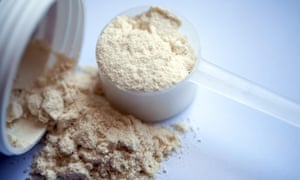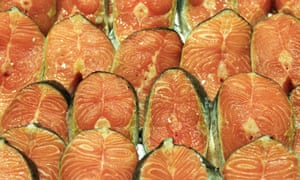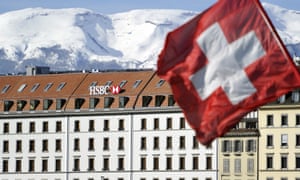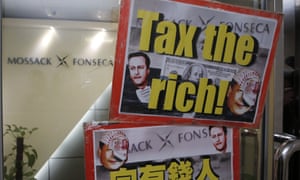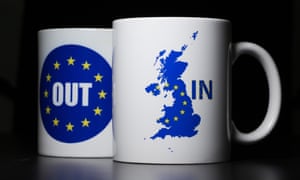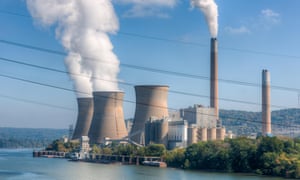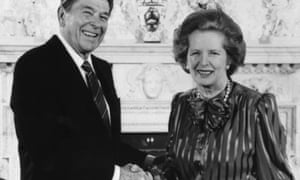The results of the rampant inequality engineered by the global elite are finally catching up with them writes Aditya Chakrabortty in The Guardian
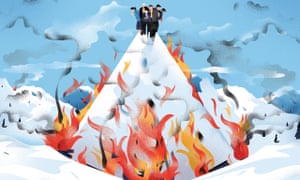
‘This backlash is uglier and more uncouth than anything you’ll see in the snow-capped Alps but the high rollers meeting there can claim exec producer credits for the whole rotten lot.’ Illustration: Nathalie Lees
Pity the poor billionaire, for today he feels a new and unsettling emotion: fear. The world order he once clung to is crumbling faster than the value of the pound. In its place, he frets, will come chaos. Remember this, as the plutocrats gather this week high above us in the ski resort of Davos: they are terrified.
Whatever dog-eared platitudes they may recycle for the TV cameras, what grips them is the havoc far below. Just look at the new report from the summit organisers that begins by asking plaintively, “Is the world sleepwalking into a crisis?” In the accompanying survey of a thousand bosses, money men (because finance, like wealth, is still mainly a male thing) and other “Davos decision-makers”, nine out of 10 say they fear a trade war or other “economic confrontation between major powers”. Most confess to mounting anxieties about “populist and nativist agendas” and “public anger against elites”. As the cause of this political earthquake, they identify two shifting tectonic plates: climate change and “increasing polarisation of societies”.
In its pretend innocence, its barefaced blame-shifting, its sheer ruddy sauce, this is akin to arsonists wailing about the flames from their own bonfire. Populism of all stripes may be anathema to the billionaire class, but they helped create it. For decades, they inflicted insecurity on the rest of us and told us it was for our own good. They have rigged an economic system so that it paid them bonanzas and stiffed others. They have lobbied and funded politicians to give them the easiest of rides. Topped with red Maga caps and yellow vests, this backlash is uglier and more uncouth than anything you’ll see in the snow-capped Alps, but the high rollers meeting there can claim exec producer credits for the whole rotten lot. Shame it’s such a downer for dividends.
This week’s report from Oxfam is just the latest to put numbers to this hoarding of wealth and power. One single minibus-load of fatcats – just 26 people – now own as much as half the planet’s population, and the collective wealth of the billionaire class swells by $2.5bn every day. This economic polarisation is far more obscene than anything detested by Davos man, and it is the root cause of the social and political divide that now makes his world so unstable.
No natural force created this intense unfairness. The gulf between the super-rich and the rest of us did not gape wide open overnight. Rather, it has been decades in the widening and it was done deliberately. The UK was the frontline of the war to create greater inequality: in her first two terms as prime minister, Margaret Thatcher more than halved the top rate of income tax paid by high earners. She broke the back of the trade unions. Over their 16 years in office, Thatcher and John Major flogged off more public assetsthan France, Italy, Spain, Germany, Australia and Canada put together.
Oh, shrug the Davos set, that’s ancient history. It is no such thing. Thatcher may be gone but her ideology keeps on taking cash out of your pay packets. If workers today got the same share of national income as in the 70s, we would be far better off. According to calculations from the Foundational Economy collective of researchers, a full-time employee now on the median salary of £29,574 would get a pay rise of £5,471.
Meanwhile, FTSE bosses enjoy skyrocketing pay, precisely because bonus schemes give them part-ownership of the big companies they run. So Jeff Fairburn of the housebuilder Persimmon took £47m in 2018 before getting the boot, which works out at £882 for each £1 earned by an average worker at the firm.
Where Thatcher’s shock troops led, the rest of the west more or less followed. Political leaders across the spectrum gave the rich what they wanted. It didn’t matter whether you voted for Tony Blair or David Cameron, Bill Clinton or George W Bush, either way you got Davos man. They cut taxes for top earners and for businesses, they uprooted the public sector to create opportunities for private firms, and they struck trade deals negotiated in secret that gave big corporations as much as they could ever dream of.
At last, more than a decade after the banking crash, the regime has run out of road. Hence the popular anger, so ferocious that the political and financial elites can neither comprehend nor control it. I can think of no better metaphor for the current disarray of the Davos set than the fact that Emmanuel Macron – surely the elite’s platonic ideal of a politician, with his eyes of leporid brightness, his stint as an investment banker and his start-up party – cannot attend this week’s jamboree because he has to stay at home and deal with the gilets jaunes. It’s a bummer when the working poor spoil your holiday plans.
None of this is to say that the 1% – holed up in their resort and fenced off from the world with roadblocks and men toting sharpshooters – don’t care about the immiseration of others. At Davos a couple of years ago, the New York Times reported that among the summit’s attractions was “a simulation of a refugee’s experience, where [conference] attendees crawl on their hands and knees and pretend to flee from advancing armies”. The article continued, “It is one of the most popular events every year.”
They care about other people’s problems – so long as they get to define them, and it’s never acknowledged that they are a large part of the problem. Which they are. If they want capitalism to carry on, the rich will need to give up their winnings and cede some ground. That point evades them. Welcoming Donald Trump last year, Klaus Schwab, Davos’s majordomo, praised the bigot-in-chief’s tax cuts for the rich and said, “I’m aware that your strong leadership is open to misconceptions and biased interpretations.” The super-rich don’t hate all populists – just those who refuse to make them richer.
Cutting the ribbon on this new economic order back in the 80s, Ronald Reagan claimed that the nine most terrifying words in the English language were: “I’m from the government and I’m here to help.” A joke perhaps, but the intention was real enough. The last three decades have seen the political and economic elites hack away at our social scaffolding – rights, taxes and institutions. It proved profitable, for a while, but now it threatens their own world. And still they block the quite reasonable alternatives of more taxes on wealth, of more power for workers, of companies not run solely to enrich their owners. The solutions to this crisis will not be handed down from a mountain top to the grateful hordes: they will rely on us taking power for ourselves. Three decades after Reagan, the nine most laughable words in the English language are: “I’m from the elite and I’m here to help.”

‘This backlash is uglier and more uncouth than anything you’ll see in the snow-capped Alps but the high rollers meeting there can claim exec producer credits for the whole rotten lot.’ Illustration: Nathalie Lees
Pity the poor billionaire, for today he feels a new and unsettling emotion: fear. The world order he once clung to is crumbling faster than the value of the pound. In its place, he frets, will come chaos. Remember this, as the plutocrats gather this week high above us in the ski resort of Davos: they are terrified.
Whatever dog-eared platitudes they may recycle for the TV cameras, what grips them is the havoc far below. Just look at the new report from the summit organisers that begins by asking plaintively, “Is the world sleepwalking into a crisis?” In the accompanying survey of a thousand bosses, money men (because finance, like wealth, is still mainly a male thing) and other “Davos decision-makers”, nine out of 10 say they fear a trade war or other “economic confrontation between major powers”. Most confess to mounting anxieties about “populist and nativist agendas” and “public anger against elites”. As the cause of this political earthquake, they identify two shifting tectonic plates: climate change and “increasing polarisation of societies”.
In its pretend innocence, its barefaced blame-shifting, its sheer ruddy sauce, this is akin to arsonists wailing about the flames from their own bonfire. Populism of all stripes may be anathema to the billionaire class, but they helped create it. For decades, they inflicted insecurity on the rest of us and told us it was for our own good. They have rigged an economic system so that it paid them bonanzas and stiffed others. They have lobbied and funded politicians to give them the easiest of rides. Topped with red Maga caps and yellow vests, this backlash is uglier and more uncouth than anything you’ll see in the snow-capped Alps, but the high rollers meeting there can claim exec producer credits for the whole rotten lot. Shame it’s such a downer for dividends.
This week’s report from Oxfam is just the latest to put numbers to this hoarding of wealth and power. One single minibus-load of fatcats – just 26 people – now own as much as half the planet’s population, and the collective wealth of the billionaire class swells by $2.5bn every day. This economic polarisation is far more obscene than anything detested by Davos man, and it is the root cause of the social and political divide that now makes his world so unstable.
No natural force created this intense unfairness. The gulf between the super-rich and the rest of us did not gape wide open overnight. Rather, it has been decades in the widening and it was done deliberately. The UK was the frontline of the war to create greater inequality: in her first two terms as prime minister, Margaret Thatcher more than halved the top rate of income tax paid by high earners. She broke the back of the trade unions. Over their 16 years in office, Thatcher and John Major flogged off more public assetsthan France, Italy, Spain, Germany, Australia and Canada put together.
Oh, shrug the Davos set, that’s ancient history. It is no such thing. Thatcher may be gone but her ideology keeps on taking cash out of your pay packets. If workers today got the same share of national income as in the 70s, we would be far better off. According to calculations from the Foundational Economy collective of researchers, a full-time employee now on the median salary of £29,574 would get a pay rise of £5,471.
Meanwhile, FTSE bosses enjoy skyrocketing pay, precisely because bonus schemes give them part-ownership of the big companies they run. So Jeff Fairburn of the housebuilder Persimmon took £47m in 2018 before getting the boot, which works out at £882 for each £1 earned by an average worker at the firm.
Where Thatcher’s shock troops led, the rest of the west more or less followed. Political leaders across the spectrum gave the rich what they wanted. It didn’t matter whether you voted for Tony Blair or David Cameron, Bill Clinton or George W Bush, either way you got Davos man. They cut taxes for top earners and for businesses, they uprooted the public sector to create opportunities for private firms, and they struck trade deals negotiated in secret that gave big corporations as much as they could ever dream of.
At last, more than a decade after the banking crash, the regime has run out of road. Hence the popular anger, so ferocious that the political and financial elites can neither comprehend nor control it. I can think of no better metaphor for the current disarray of the Davos set than the fact that Emmanuel Macron – surely the elite’s platonic ideal of a politician, with his eyes of leporid brightness, his stint as an investment banker and his start-up party – cannot attend this week’s jamboree because he has to stay at home and deal with the gilets jaunes. It’s a bummer when the working poor spoil your holiday plans.
None of this is to say that the 1% – holed up in their resort and fenced off from the world with roadblocks and men toting sharpshooters – don’t care about the immiseration of others. At Davos a couple of years ago, the New York Times reported that among the summit’s attractions was “a simulation of a refugee’s experience, where [conference] attendees crawl on their hands and knees and pretend to flee from advancing armies”. The article continued, “It is one of the most popular events every year.”
They care about other people’s problems – so long as they get to define them, and it’s never acknowledged that they are a large part of the problem. Which they are. If they want capitalism to carry on, the rich will need to give up their winnings and cede some ground. That point evades them. Welcoming Donald Trump last year, Klaus Schwab, Davos’s majordomo, praised the bigot-in-chief’s tax cuts for the rich and said, “I’m aware that your strong leadership is open to misconceptions and biased interpretations.” The super-rich don’t hate all populists – just those who refuse to make them richer.
Cutting the ribbon on this new economic order back in the 80s, Ronald Reagan claimed that the nine most terrifying words in the English language were: “I’m from the government and I’m here to help.” A joke perhaps, but the intention was real enough. The last three decades have seen the political and economic elites hack away at our social scaffolding – rights, taxes and institutions. It proved profitable, for a while, but now it threatens their own world. And still they block the quite reasonable alternatives of more taxes on wealth, of more power for workers, of companies not run solely to enrich their owners. The solutions to this crisis will not be handed down from a mountain top to the grateful hordes: they will rely on us taking power for ourselves. Three decades after Reagan, the nine most laughable words in the English language are: “I’m from the elite and I’m here to help.”
